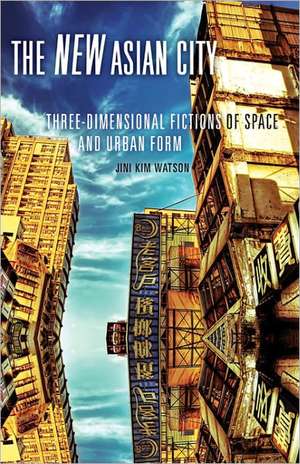The New Asian City: Three-Dimensional Fictions of Space and Urban Form
Autor Jini Kim Watsonen Limba Engleză Paperback – 9 noi 2011
Under Jini Kim Watson’s scrutiny, the Asian Tiger metropolises of Seoul, Taipei, and Singapore reveal a surprising residue of the colonial environment. Drawing on a wide array of literary, filmic, and political works, and juxtaposing close readings of the built environment, Watson demonstrates how processes of migration and construction in the hypergrowth urbanscapes of the Pacific Rim crystallize the psychic and political dramas of their colonized past and globalized present.
Examining how newly constructed spaces—including expressways, high-rises, factory zones, department stores, and government buildings—become figured within fictional and political texts uncovers how massive transformations of citizenries and cities were rationalized, perceived, and fictionalized. Watson shows how literature, film, and poetry have described and challenged contemporary Asian metropolises, especially around the formation of gendered and laboring subjects in these new spaces. She suggests that by embracing the postwar growth-at-any-cost imperative, they have buttressed the nationalist enterprise along neocolonial lines.
The New Asian City provides an innovative approach to how we might better understand the gleaming metropolises of the Pacific Rim. In doing so, it demonstrates how reading cultural production in conjunction with built environments can enrich our knowledge of the lived consequences of rapid economic and urban development.
Examining how newly constructed spaces—including expressways, high-rises, factory zones, department stores, and government buildings—become figured within fictional and political texts uncovers how massive transformations of citizenries and cities were rationalized, perceived, and fictionalized. Watson shows how literature, film, and poetry have described and challenged contemporary Asian metropolises, especially around the formation of gendered and laboring subjects in these new spaces. She suggests that by embracing the postwar growth-at-any-cost imperative, they have buttressed the nationalist enterprise along neocolonial lines.
The New Asian City provides an innovative approach to how we might better understand the gleaming metropolises of the Pacific Rim. In doing so, it demonstrates how reading cultural production in conjunction with built environments can enrich our knowledge of the lived consequences of rapid economic and urban development.
Preț: 221.28 lei
Nou
Puncte Express: 332
Preț estimativ în valută:
42.42€ • 44.52$ • 34.98£
42.42€ • 44.52$ • 34.98£
Carte tipărită la comandă
Livrare economică 23 ianuarie-06 februarie 25
Preluare comenzi: 021 569.72.76
Specificații
ISBN-13: 9780816675739
ISBN-10: 0816675732
Pagini: 312
Ilustrații: 14
Dimensiuni: 140 x 216 x 23 mm
Greutate: 0.45 kg
Ediția:New.
Editura: University of Minnesota Press
Colecția Univ Of Minnesota Press
ISBN-10: 0816675732
Pagini: 312
Ilustrații: 14
Dimensiuni: 140 x 216 x 23 mm
Greutate: 0.45 kg
Ediția:New.
Editura: University of Minnesota Press
Colecția Univ Of Minnesota Press
Notă biografică
Jini Kim Watson is assistant professor of English and comparative literature at New York University.
Cuprins
Contents
Note on Romanization
Introduction: The Production of Space in Singapore, Seoul, and Taipei
Part I. Colonial Cities
1. Imagining the Colonial City
2. Orphans of Asia: Modernity and Colonial Literature
Export Production and the Blank Slate
Part II. Postwar Urbanism
3. Narratives of Human Growth versus Urban Renewal
4. The Disappearing Woman, Interiority, and Private Space
Roads, Railways, and Bridges: Arteries of the Nation
Part III. Industrializing Landscapes
5. The Way Ahead: The Politics and Poetics of Singapore’s Developmental Landscape
6. Mobility and Migration in Taiwanese New Cinema
7. The Redemptive Realism of Korean Minjung Literature
Conclusion. Too Late, Too Soon: Globalization and New Asian Cities
Acknowledgments
Notes
Bibliography
Index
Note on Romanization
Introduction: The Production of Space in Singapore, Seoul, and Taipei
Part I. Colonial Cities
1. Imagining the Colonial City
2. Orphans of Asia: Modernity and Colonial Literature
Export Production and the Blank Slate
Part II. Postwar Urbanism
3. Narratives of Human Growth versus Urban Renewal
4. The Disappearing Woman, Interiority, and Private Space
Roads, Railways, and Bridges: Arteries of the Nation
Part III. Industrializing Landscapes
5. The Way Ahead: The Politics and Poetics of Singapore’s Developmental Landscape
6. Mobility and Migration in Taiwanese New Cinema
7. The Redemptive Realism of Korean Minjung Literature
Conclusion. Too Late, Too Soon: Globalization and New Asian Cities
Acknowledgments
Notes
Bibliography
Index
Recenzii
"The New Asian City is capacious, probing, and exciting as it cuts across Asian global fields: Jini Kim Watson makes the Pacific Rim urban space boom, transform, and resonate with life force, social knowledge, and urban creativity." —Rob Wilson, author of Reimagining the American Pacific: From ‘South Pacific’ to Bamboo Ridge and Beyond
"This is an unusually interesting book. It is remarkable not because the New Asian City is analyzed in terms of the latest urban theory available, but because it demonstrates how much farther urban theory has to go to catch up with the Asian city." —Ackbar Abbas, author of Hong Kong: Culture and the Politics of Disappearance
Descriere
Cultural productions reveal a darker side to development in emblematic Asian Tiger cities
